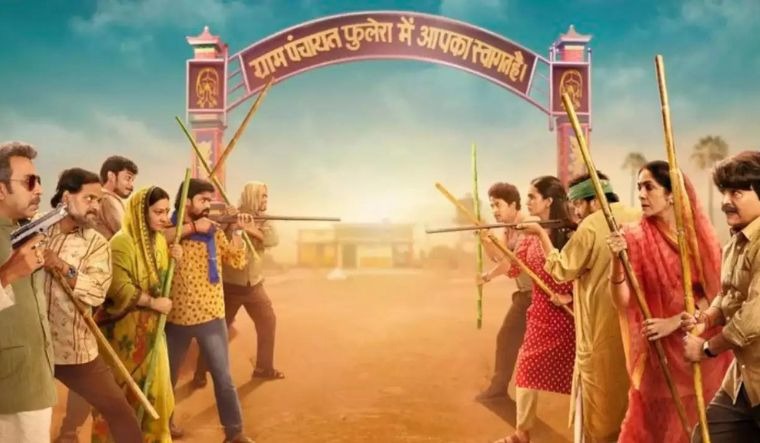
Panchayat Season 3: A Cinematic Masterpiece Culminates in an Explosive Finale
The TVF original series Panchayat has garnered significant praise for its realistic portrayal of rural India, its rich character development, and its blend of humor and drama. The show, which revolves around the trials and tribulations of Abhishek Tripathi, a young man working as a Panchayat secretary in the fictional village of Phulera, reached a thrilling climax in its third season. The last episode, titled “Hamla” (meaning “attack”), stands out as a cinematic tour de force, captivating audiences with its intense action, sharp narrative twists, and exceptional cinematography.
A Brewing Storm: The Lead-Up to the Finale
The final episode kicks off with tensions running high. The animosity between the villagers of Phulera and the local MLA (Member of Legislative Assembly) has been escalating, particularly after a contentious horse deal that leaves the MLA fuming. This conflict sets the stage for a dramatic showdown that will test the resilience and unity of the villagers.
The MLA’s Assault on Phulera
The episode’s initial scenes are a visual and auditory feast, showcasing the MLA’s convoy advancing toward Phulera. The background music heightens the sense of impending doom, perfectly complementing the visuals of the heavily armed convoy snaking through the rural landscape. The MLA, portrayed with menacing charisma, leads this aggressive display of power, intent on making the villagers pay for their defiance.
The cinematography here is nothing short of spectacular. The sweeping shots of the convoy, interspersed with close-ups of the determined faces of the MLA’s henchmen, build a palpable sense of tension. As the convoy enters Phulera, the villagers, armed with sticks and makeshift weapons, prepare to defend their home. This confrontation is a masterclass in rural warfare, depicting how ordinary villagers, lacking tactical skills, muster the courage to stand up against a well-armed force.
The Standoff: Villagers vs. Goons
The standoff between the villagers and the MLA’s goons is a scene of raw, unfiltered emotion. The camera work here is particularly noteworthy, capturing the fear, anger, and determination etched on the villagers’ faces. The visual juxtaposition of the rustic simplicity of the villagers’ weapons against the modern firearms of the MLA’s goons highlights the stark power imbalance.
Prahlad Cha, affectionately dubbed ‘Sniper Chacha,’ takes a strategic position atop a water tank, his presence adding a touch of both humor and heroism to the scene. This element of the story not only underscores the villagers’ resourcefulness but also provides a moment of levity amidst the tension.
As the confrontation reaches its peak, a senior politician intervenes, preventing what could have been a devastating conflict. Shots are fired into the air, creating a nerve-wracking atmosphere that keeps viewers on the edge of their seats. This intervention, though averting immediate bloodshed, leaves the situation unresolved, setting the stage for further developments.
The Ambush: A Sudden Twist
A few days later, as Abhishek prepares to leave for his CAT exam, the story takes an unexpected turn. Abhishek and his friends are ambushed by gunmen, resulting in Pradhan Ji being shot in the shoulder. This sudden burst of violence shocks both the characters and the audience, demonstrating the precariousness of their situation.
The hospital scene that follows is charged with tension. Abhishek, driven by anger and frustration, confronts the MLA and Bhushan, accusing them of orchestrating the attack. The MLA’s denial and subsequent accusation that Pradhan Ji staged the attack for sympathy votes adds another layer of complexity to the narrative. This confrontation escalates into a physical altercation, leading to both groups being detained at the police station.
A Cliffhanger Ending
True to the show’s style, the season ends on a cliffhanger, leaving fans eagerly speculating about what will happen next. This unresolved tension, much like in previous seasons, ensures that the audience remains hooked, eagerly anticipating the continuation of the story.
Masterful Cinematography and Direction
One of the standout aspects of this episode is its cinematography. The visual storytelling is impeccable, with each frame meticulously crafted to enhance the narrative. The use of wide shots to capture the scale of the conflict, combined with intimate close-ups that convey the characters’ emotions, creates a dynamic viewing experience.
The action sequences, in particular, are executed with precision and creativity. The way the villagers, despite their lack of professional training, come together to defend their home is portrayed with authenticity and respect. The scene where the MLA’s goons and the villagers face off, brandishing their respective weapons, is both aesthetically pleasing and emotionally gripping.
The background music and sound effects further elevate the episode. The score complements the visuals perfectly, heightening the tension and drama at crucial moments. The sound of the convoy approaching, the rustling of the villagers preparing for battle, and the gunshots ringing through the air all contribute to an immersive auditory experience.
Character Development and Performances
The strength of Panchayat lies in its rich character development and the stellar performances of its cast. The final episode showcases the growth and evolution of the characters, particularly Abhishek and Pradhan Ji. Abhishek’s journey from a reluctant outsider to a committed member of the community is portrayed with nuance and depth. His confrontation with the MLA is a pivotal moment, highlighting his transformation and the strength of his convictions.
Pradhan Ji’s resilience and leadership are also on full display. Despite being injured, his determination to protect his village and stand up against injustice is inspiring. The supporting cast, including Prahlad Cha, adds layers of humor and humanity to the story, making the village of Phulera feel like a real, living community.
Thematic Depth
Beyond its action and drama, “Hamla” delves into deeper themes of power, resistance, and community. The episode explores the dynamics of rural politics and the impact of corruption and power struggles on ordinary lives. The villagers’ collective action against the MLA’s tyranny serves as a powerful commentary on the strength of unity and the importance of standing up for one’s rights.
Conclusion: A Triumph in Storytelling
In conclusion, the final episode of Panchayat Season 3, “Hamla,” is a cinematic triumph. The team’s meticulous attention to detail, exceptional cinematography, and compelling storytelling come together to create a gripping and memorable viewing experience. The episode’s blend of action, emotion, and thematic depth makes it a standout in the series and a testament to the talent and creativity of the creators.
As fans eagerly await the next season, the cliffhanger ending of “Hamla” ensures that Panchayat remains a beloved and highly anticipated show. The series continues to resonate with audiences, capturing the essence of rural India while telling a universally relatable story of resilience, community, and the fight for justice.
